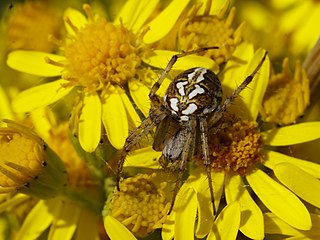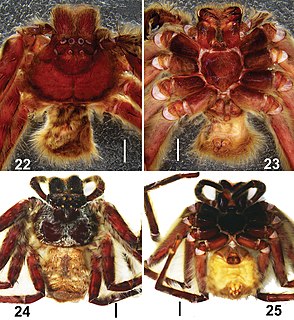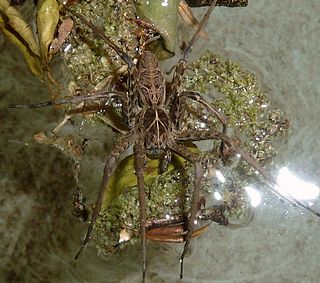
Orb-weaver spiders are members of the spider family Araneidae. They are the most common group of builders of spiral wheel-shaped webs often found in gardens, fields, and forests. The English word orb can mean "circular", hence the English name of the group. Araneids have eight similar eyes, hairy or spiny legs, and no stridulating organs.

Hyllus is a genus of the spider family Salticidae.
Meleon is a genus of jumping spiders that was first described by F. R. Wanless in 1984.
Pellolessertia is a monotypic genus of African jumping spiders containing the single species, Pellolessertia castanea. It was first described in 1927, and is only found in Africa. Dippenaar-Schoeman & Jocqué gave the distribution range as Zad're to Ethiopia.
Schenkelia is a genus of jumping spiders that was first described by R. de Lessert in 1927.

Neoscona, known as spotted orb-weavers and barn spiders, is a genus of orb-weaver spiders (Araneidae) first described by Eugène Simon in 1895 to separate these from other araneids in the now obsolete genus Epeira. The name Neoscona was derived from the Greek νέω, meaning "spin", and σχοῐνος, meaning "reed" They have a mostly pantropical distribution and one species, Neoscona adianta, has a palearctic distribution. As of April 2019 there are eight species that can be found in the United States and Canada:

Oxyopes is a genus of lynx spiders found worldwide. It includes arounds 300 species and is classified under the lynx spider family Oxyopidae. Like other lynx spiders, they are easily recognizable by the six larger eyes arranged hexagonally on top of the head (prosoma), with the remaining smaller two eyes in front. They are also characterized by long spine-like bristles (setae) on their legs. They are ambush predators, actively hunting prey by sight. Though they produce and use silk, they do not build webs to capture prey.
Stiphropus is a genus of crab spiders in the family Thomisidae, containing twenty species from Africa and Asia.
Merenius is a genus of corinnid sac spiders first described by Eugène Simon in 1910.
Faradja is a genus of Central African orb-weaver spiders containing the single species, Faradja faradjensis. It was first described by M. Grasshoff in 1970, and has only been found in Middle Africa.
Kilima is a genus of African orb-weaver spiders first described by M. Grasshoff in 1970. As of April 2019 it contains only three species.

Lariniaria is a genus of Asian orb-weaver spiders containing the single species, Lariniaria argiopiformis. It was first described by M. Grasshoff in 1970, and has only been found in Russia, China, Korea, and Japan.
Mahembea is a genus of African orb-weaver spiders containing the single species, Mahembea hewitti. It was first created by M. Grasshoff in 1970 to separate this species from its original genus, Larinia. It has only been found in Central and East Africa.
Prasonica is a genus of orb-weaver spiders first described by Eugène Simon in 1895.

Barylestis is a genus of huntsman spiders that was first described by Eugène Louis Simon in 1910.
Charminus is a genus of nursery web spiders that was first described by Tamerlan Thorell in 1899.

Cispius is a genus of African nursery web spiders that was first described by Eugène Louis Simon in 1898.
Siwa is a genus of orb-weaver spiders first described by M. Grasshoff in 1970. As of April 2019 it contains only two species.
Mystaria is a genus of African crab spiders first described by Eugène Simon in 1895.






